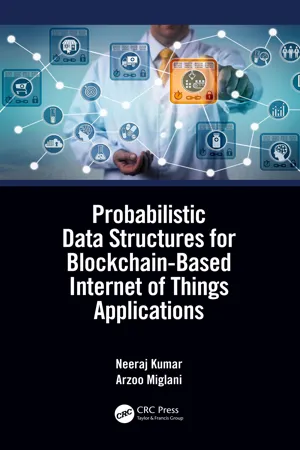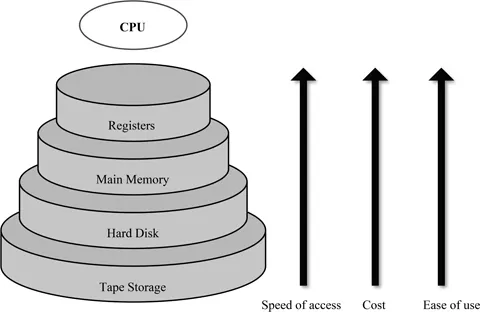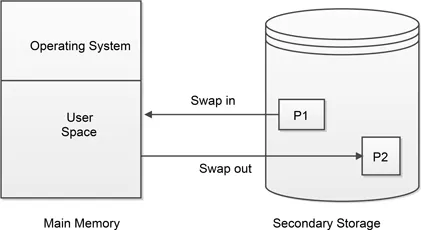
eBook - ePub
Probabilistic Data Structures for Blockchain-Based Internet of Things Applications
This is a test
- 320 pages
- English
- ePUB (mobile friendly)
- Available on iOS & Android
eBook - ePub
Probabilistic Data Structures for Blockchain-Based Internet of Things Applications
Book details
Book preview
Table of contents
Citations
About This Book
This book covers theory and practical knowledge of Probabilistic data structures (PDS) and Blockchain (BC) concepts. It introduces the applicability of PDS in BC to technology practitioners and explains each PDS through code snippets and illustrative examples. Further, it provides references for the applications of PDS to BC along with implementation codes in python language for various PDS so that the readers can gain confidence using hands on experience. Organized into five sections, the book covers IoT technology, fundamental concepts of BC, PDS and algorithms used to estimate membership query, cardinality, similarity and frequency, usage of PDS in BC based IoT and so forth.
Frequently asked questions
At the moment all of our mobile-responsive ePub books are available to download via the app. Most of our PDFs are also available to download and we're working on making the final remaining ones downloadable now. Learn more here.
Both plans give you full access to the library and all of Perlego’s features. The only differences are the price and subscription period: With the annual plan you’ll save around 30% compared to 12 months on the monthly plan.
We are an online textbook subscription service, where you can get access to an entire online library for less than the price of a single book per month. With over 1 million books across 1000+ topics, we’ve got you covered! Learn more here.
Look out for the read-aloud symbol on your next book to see if you can listen to it. The read-aloud tool reads text aloud for you, highlighting the text as it is being read. You can pause it, speed it up and slow it down. Learn more here.
Yes, you can access Probabilistic Data Structures for Blockchain-Based Internet of Things Applications by Neeraj Kumar,Arzoo Miglani in PDF and/or ePUB format, as well as other popular books in Computer Science & Computer Science General. We have over one million books available in our catalogue for you to explore.
Information
Part III
Probabilistic Data Structures: An Overview
9
Introduction to Probabilistic Data Structures
9.1 Need of Probabilistic Data Structures
There is an exponential increase in the generation of data since last few years. This heavy data growth poses a challenge for industry and academia for storage and query processing. While analyzing logs for huge data sets, it is required to perform different query operations, such as counting unique items, computing frequency of a data item, searching any item in a set, etc. Additionally, we need to probe more complex datasets, such as images, videos, web pages, etc. Clearly, in order to process such query operations on data, it is essential to store data in computer memory. Tapes, hard disk, solid state drives are different types of memory available for a computing system. However, these different types of memory have different characteristics as presented in Fig. 9.1. For example, hard disks are mechanical devices and they are slow to access as compared to main memory integrated on a semiconductor chip which makes querying from database in hard disk time consuming. Hence, for a query, a processor has to every time access the hard disk for the data it requires which clearly would be a slow operation. Also, disk access proves costly as compared to the main memory (that's why a GB of main memory is much costlier than a GB of hard drive).

FIGURE 9.1
Computer memory hierarchy.
Computer memory hierarchy.
Besides, a process needs to be in the main memory in order to get executed so, it has to get swapped in from secondary memory to main memory as depicted in Fig. 9.2. Simultaneously, for a developer, main memory is easy to use as creating an array, linked list, or set in main memory is easy as compared to writing files in or out by using a Hadoop database or Apache Solr in secondary storage. These upcoming big data technologies are oftenly used in providing accurate analysis and decision making. These technologies provide distributed data storage and parallel processing. Although the distributed database Hadoop with a heavy processing engine (Spark, MapReduce) is good with batch processing framework where the aim is to improve job throughput rather than handling speed of access issue. Notably, the batch processing of data doesn't impose any time constraints so, it can be stored on disk and queries can be processed in batches. Additionally, the popular approach of using SQL for processing queries on database in secondary storage results in high space complexity. For instance, Powerdrill is a column oriented data storage approach that faces the challenge of high memory and computational overhead for large datasets. However, streaming data requires real-time processing with a minimal delay which is possible with improved speed of access. Moreover, streaming data requires processing in a single pass. So, it is always better to work more in main memory for real-time processing of streaming data along with processing data in a single pass. Subsequently, the growing size of databases and applications dataset demands a compact data structure in order to get managed and handled properly.

FIGURE 9.2
Memory management via swapping.
Memory management via swapping.
The current scenario of data generation has resulted in the release of new applications that need to deal with a huge volume of data. Conventional algorithms assumption of fitting data in main memory fails when dealing with such a huge amount of data. In this context, streaming algorithms (that process data in one or a few passes while consuming a limited amount of storage and time) are getting popular among researchers.
Unfortunately, in order to fix above mentioned issue, deterministic data structures, such as hash tables, array, binary search tree fail to deal with large data sets as it is difficult to accommodate large streaming data into memory at once. The conventional data structures can't go on the further side of linear processing. Moreover, for large dataset, a polynomial running time complexity served by deterministic data structures is not beneficial. Also, 3 V's (volume, variety, and velocity) of data demands real-time analy...
Table of contents
- Cover
- Half Title
- Title Page
- Copyright Page
- Contents
- Foreword
- Preface
- Biography
- I Background
- II Blockchain Overview
- III Probabilistic Data Structures: An Overview
- IV Integration of Probabilistic Data Structures with Blockchain
- Bibliography
- Index